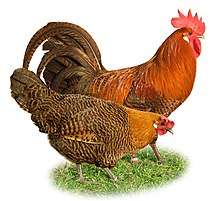Braekel
The Braekel or Brakel is a traditional Belgian breed of chicken. It is thought to have originated in the area of Brakel, in the Flemish province of East Flanders, for which it is named.[6]:43 There is a bantam version of the Braekel.[7] The Campine of the United Kingdom derives from it.
 | |
| Other names |
|
|---|---|
| Country of origin | Belgium |
| Use | eggs |
| Traits | |
| Weight | |
| Egg colour | white[2] |
| Classification | |
| APA | not listed[3] |
| EE | yes[4] |
| PCGB | rare soft feather: light[5] |
| |
History
The Braekel apparently derives from same extended population of gold and silver chickens which gave rise to the closely similar Ostfriesische Möwe and Westfälischer Totleger breeds.[6]:43 It is thought to have originated in the area of Brakel, in the Flemish province of East Flanders, and particularly in the villages of Opbrakel and Nederbrakel; and to have spread along the valleys of the Scheldt and Dender rivers, in East Flanders and into Hainaut.[6]:43
In 1884 two distinct types were recognised as separate breeds: the larger Braekel of Flanders, and a smaller and lighter type from the Campine region to the east. In 1898 a Braekel breeders' society was established in Nederbrakel, and a breed standard was published. In 1926 the separate Braekel and Campine breeds were brought together again under a single breed standard.[6]:43
In the United Kingdom a very different Campine breed was created, probably through cross-breeding with pencilled Hamburgs. The principal difference is that cock birds display hen-feathering, which was not seen in the Belgian type.[6]:43
The Braekel population declined during and after the Second World War and it is a rare breed.
Characteristics
The Braekel is a light breed; cocks weigh 2–2.5 kg and hens 1.8–2.2 kg.[1] Bantam cocks weigh about 800 g and hens about 700 g.[7] Ring sizes are 18 mm and 16 mm for standard-sized cocks and hens, and 13 mm and 11 mm respectively for bantams.[7]
A straight banding pattern of the feathers and a uniform solid neck colour are characteristic of the Braekel. Several colour variants exist, with the gold and the silver variant being the most common.
Use
Braekel hens lay well from the age of six or seven months, and in a year may produce approximately 180 white-shelled eggs weighing 60–65 g.[6]:44
References
| Wikimedia Commons has media related to Braekel. |
- Het Brakelhoen (in Dutch). Lierde: Braekelclub-Nederbraekel. Accessed August 2014.
- Victoria Roberts (2008). British poultry standards: complete specifications and judging points of all standardized breeds and varieties of poultry as compiled by the specialist breed clubs and recognised by the Poultry Club of Great Britain. Oxford: Blackwell. ISBN 9781405156424. p. 84.
- APA Recognized Breeds and Varieties: As of January 1, 2012. American Poultry Association. Archived 4 November 2017.
- Liste des races et variétés homologuée dans les pays EE (28.04.2013). Entente Européenne d’Aviculture et de Cuniculture. Archived 16 June 2013.
- Breed Classification. Poultry Club of Great Britain. Archived 12 June 2018.
- N. Moula, M. Jacquet, A. Verelst, N. Antoine-Moussiaux, F. Farnir, P. Leroy (2012). Les races de poules belges (in French). Annales de Médecine Vétérinaire 156: 37-65. Accessed August 2014.
- Raskenmerken: De kenmerken van het brakelhoen (in Dutch). Brakelhoenspeciaalclub, 2011. Archived 29 May 2013.